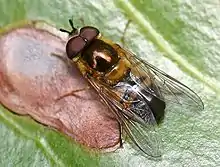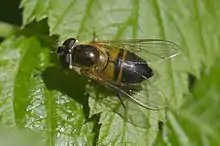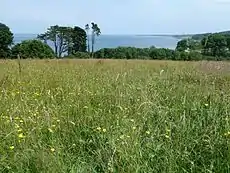| Epistrophe eligans | |
|---|---|
 | |
| male | |
 | |
| female | |
| Scientific classification | |
| Domain: | Eukaryota |
| Kingdom: | Animalia |
| Phylum: | Arthropoda |
| Class: | Insecta |
| Order: | Diptera |
| Family: | Syrphidae |
| Genus: | Epistrophe |
| Species: | E. eligans |
| Binomial name | |
| Epistrophe eligans | |
| Synonyms | |
Epistrophe eligans is a European species of hoverfly.[2][3][4][5]
Description
External images
For terms see Morphology of Diptera
Wing length 6·25-9·5 mm. Eyes bare. Stigma pale yellow. Tergite 4 with smaller yellow markings than tergite 3 or tergite 4 black.
[5]
[6]
[7][8] The larva is illustrated by Rotheray (1993) [9] The male genitalia are figured by Dusek and Laska (1967).[10]
Distribution
Palaearctic.[11] South Sweden to Iberia. Ireland East through Central and South Europe into Turkey and European Russia as far as the Caucasus.[12]

Biology
The habitat is deciduous woodland and scrub, suburban gardens, parks.[13] Found by tracksides, clearings. Flowers visited include white umbellifers, Acer pseudoplatanus, Cistus, Crataegus, Endymion, Euonymus, Euphorbia, Ilex, Prunus spinosa, Stellaria, Viburnum opulus.[14] The flight period is April to June (earlier in southern areas, later at higher altitudes and northerly latitudes). The larva is aphid feeding on shrubs and trees.
References
- 1 2 Harris, M. (1780). An exposition of English insects. Vol. Decads III, IV. London: Robson Co. pp. 73–99, 100–138, pls. 21-30, 31–40. Retrieved 16 July 2021.
- ↑ Ball, S.G.; Morris, R.K.A. (2000). Provisional atlas of British hoverflies (Diptera, Syrphidae). Monks Wood, UK: Biological Record Centre. pp. 167 pages. ISBN 1-870393-54-6.
- ↑ Morris, Roger K. A. (1999). Hoverflies of Surrey. Surrey Wildlife Trust. p. 244. ISBN 0-9526065-3-4.
- ↑ Stubbs, Alan E.; Falk, Steven J. (1983). British Hoverflies: An Illustrated Identification Guide. British Entomological & Natural History Society. p. 253, xvpp.
- 1 2 Van Veen, M.P. (2004). Hoverflies of Northwest Europe, Identification Keys to the Syrphidae (hardback). Utrecht: KNNV Publishing. p. 254. ISBN 90-5011-199-8.
- ↑ Van der Goot,V.S. (1981) De zweefvliegen van Noordwest - Europa en Europees Rusland, in het bijzonder van de Benelux. KNNV, Uitgave no.32: 275pp. Amsterdam.
- ↑ Bei-Bienko, G.Y. & Steyskal, G.C. (1988) Keys to the Insects of the European Part of the USSR, Volume V: Diptera and Siphonaptera, Part I. Amerind Publishing Co., New Delhi. ISBN 81-205-0080-6.
- ↑ Coe, R.L. (1953) Diptera: Syrphidae. Handbks.ident.Br.insects, 10(1): 1-98. R.ent.Soc.London. pdf Archived 2018-10-04 at the Wayback Machine
- ↑ Rotheray G., 1993 Colour Guide to Hoverfly Larvae Diptera, Syrphidae in Britain and Europe Dipterists Forum pdf
- ↑ Dusek, J. & Laska, P. (1967) Versuch zum aufbau eines Naturlichen Systems mitteleuropaischer Arten der Unterfamilie Syrphinae (Diptera). Acta sc.nat.Brno, 1: 349-390.
- ↑ "Epistrophe eligans (Harris, 1780)". Fauna Europaea. Retrieved 5 February 2020.
- ↑ Peck, L.V. (1988) Syrphidae. In: Soos, A. & Papp, L. (eds.) Catalogue of Palaearctic Diptera, 8: 11-230. Akad.Kiado, Budapest.
- ↑ Speight, M.C.D. (2011). "Species accounts of European Syrphidae (Diptera)" (PDF). Syrph the Net, the Database of European Syrphidae. 65: 285pp.
- ↑ de Buck, N. (1990) Bloembezoek en bestuivingsecologie van Zweefvliegen (Diptera, Syrphidae) in het bijzonder voor België. Doc.Trav. IRSNB, no.60, 1-167.